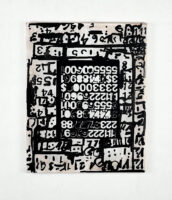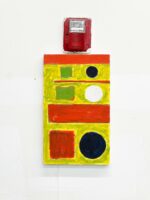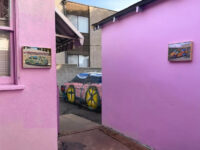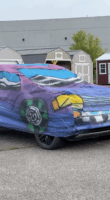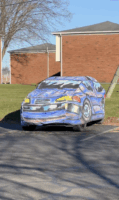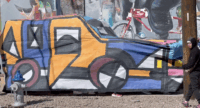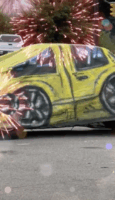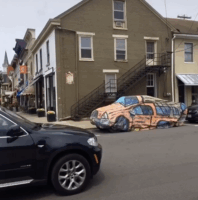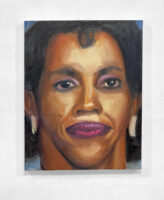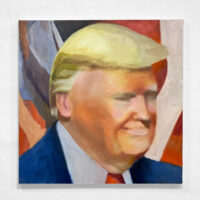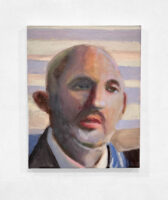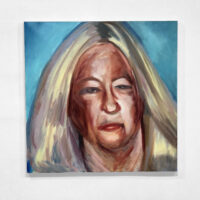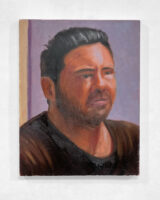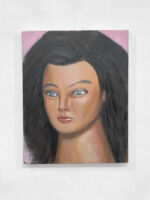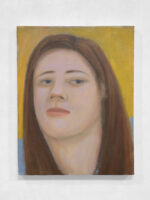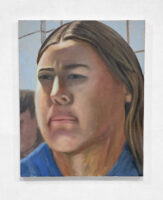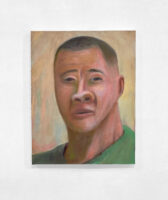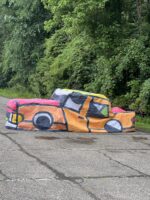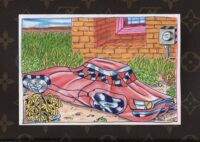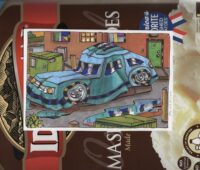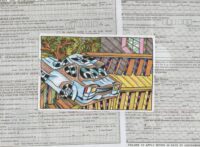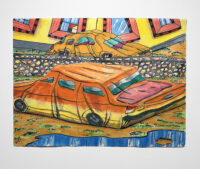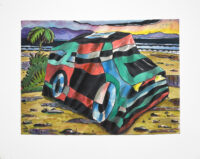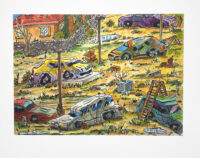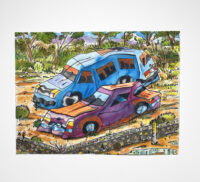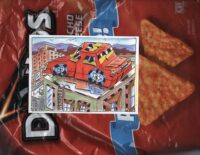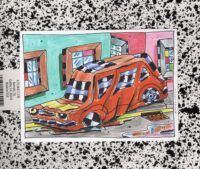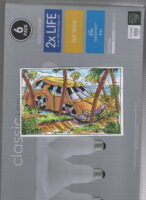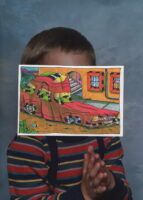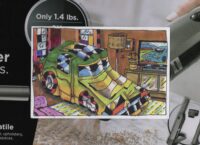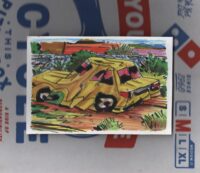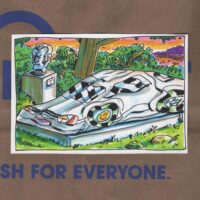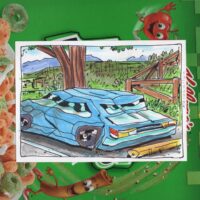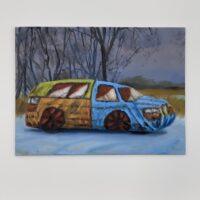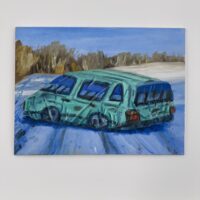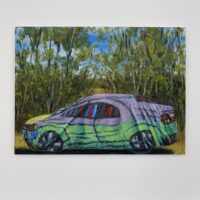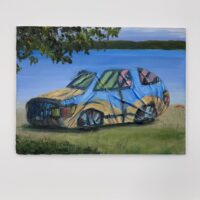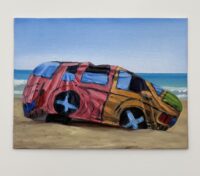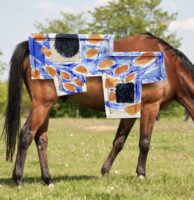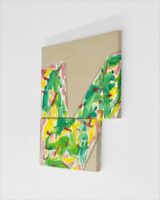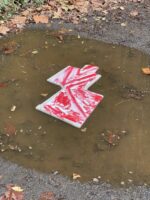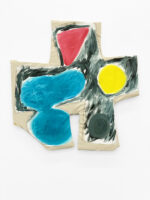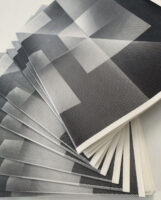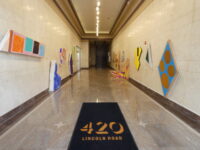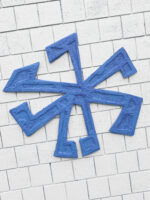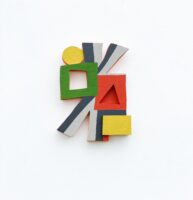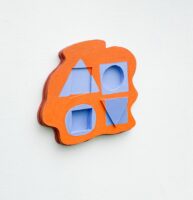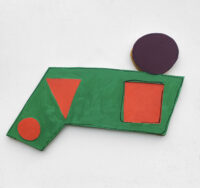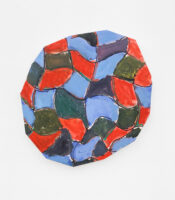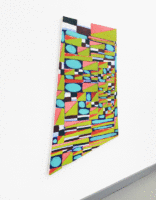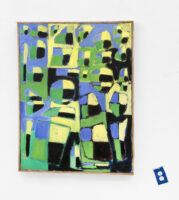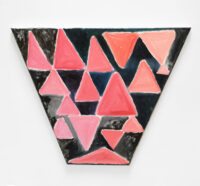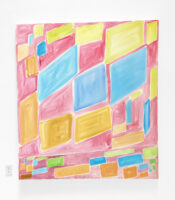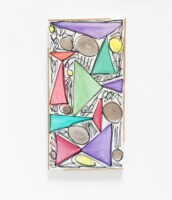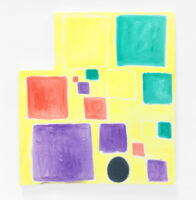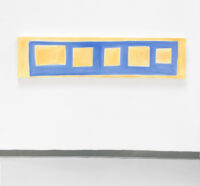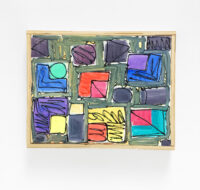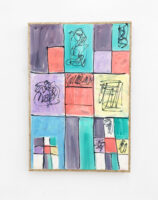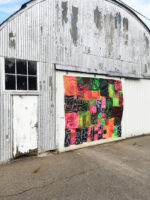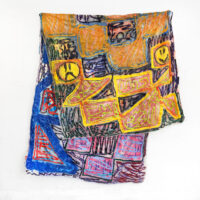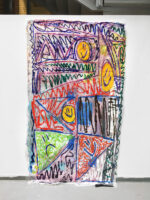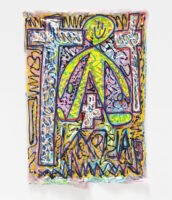- Vehicular Manslaughter
Vehicular Manslaughter, acrylic paint and vinyl sticker on stretched polytab mural fabric. Size: 18” x 24”. 2025.
- Dog with Sunglasses
Dog with Sunglasses, oil paint on stretched canvas. Size: TV tray. 2022.
- Sidebitch Project Space
(C)AR(T): Keith ALLyN Spencer & JPW3 Sidebitch Project Space, Los Angeles, California curated by Sofie Ramos
- FireCoverz Newark Earthworks
- FireCoverz El Paso Cartel
- Firecoverz Northeast Airbnb El Paso
- FireCoverz Franklinton
- FireCoverz Carwash
- Firecoverz Lowe’s Northeast El Paso
- Firecoverz Uhaul
- Firecoverz Sheds Ohio
- FireCoverz 3340 Cliffrock Lane
- FireCoverz USPS Heath Ohio
- FireCoverz Sacred Heart Church Segundo Barrio El Paso
- Firecoverz Karen Plaza
- FireCoverz WalMart El Paso
- FireCoverz Fireworks
- FireCoverz Indian Mound Mall AMC
- FireCoverz Recycling Plant
- FireCoverz Ohio BMV
- FireCoverz Granville Ohio
- Grown Man Move
Grown Man Move, oil paint on instant pancake mix cardboard box. Size: Instant Pancake Mix Cardboard Box. 2024.
- Tina
Tina, oil painting on stretched mural fabric, 9″ x 12″, 2024.
- YMCA
YMCA, oil paint on stretched mural fabric, 24″ x 24″, 2024.
- Keith Reyes
Keith Reyes, oil painting on stretched mural fabric, 9″x 12″, 2024.
- (no title)
Murderer, oil painting on stretched mural fabric, 24″ x 24″, 2024.
- Interventionist
Interventionist, oil painting on stretched mural fabric, 9″ x 12″, 2024.
- Biggie
Biggie, oil painting on stretched mural fabric, ~22″ x 14″, 2024.
- La Rockera
La Rockera, oil painting on stretched mural fabric, 9″ x 12″, 2024.
- Bad Breath
Bad Breath, oil painting on stretched mural fabric, 9″ x 12″, 2024.
- Charles Barkley
Charles Barkley, oil painting on stretched mural fabric, 9″ x 12″, 2024.
- Native American
Native American, oil painting on stretched mural fabric, ~24″ x 18″, 2024.
- El Chino
El Chino, oil painting on stretched mural fabric, 9″x12″, 2024.
- Find the 2
“Find the 2 and You will Be Kissed Tomorrow. 555555555555555555555555555555555555555555555555555555555555555555555555555555555555555555555555555555555555555555555555555555555555555555555555555555555555555555555555555555….” acrylic and spray enamel on mural fabric, Size: Small. 2024.
- Find the 2
“Find the 2 and You Will be Kissed Tomorrow. 5555555555555555…”, acrylic paint on mural fabric. 2024.
- Snow Emergency Level 2
Snow Emergency Level 2, oil paint on pancake mix cardboard box. Size: Instant Pancake Mix Cardboard Box. 2024.
- Save People Hundreds
Save People Hundreds, oil paint on poly tab mural fabric. Size: Cookie Sheet. 2023.
- Final Exam Schedule
Final Exam Schedule, oil paint on stretched canvas. Size: Chessboard. 2023.
- Pharmaceutical Management Beneficiaries
Pharmaceutical Management Beneficiaries, oil on stretched canvas. Size: chessboard. 2023.
- Joint Pain
Joint Pain, oil on stretched canvas. Size: Door Matt. 2023.
- Dog Park
Dog Park, oil paint on stretched canvas. Size: Door Matt. 2023.
- People Pleasers
Find the 2: People Pleasers, acrylic on polytab, 222” long (fits up to mini-van), 2023.
- Friendly Reminder
Find the 2: Friendly Reminder, acrylic on polytab installed on 24 cardboard boxes, ~60” x 60” x 200”, 2023. VIDEO: Find the 2
- Potpourri
Find the 2: Potpourri, markers and colored pencil on Bristol board, 6” x 4”, 2023.
- Hard to Enjoy
Find the 2: Hard to Enjoy, markers and colored pencil on Bristol board, 6” x 4”, 2023.
- Side Hug
Find the 2: Side Hug, markers and colored pencil on Bristol board, 6” x 4”, 2023.
- Free Food
Find the 2: Free Food, markers and colored pencil on Bristol board, 6” x 4”, 2023.
- Verisimilitude
Find the 2: Verisimilitude, markers and colored pencil on Bristol board, 6” x 4”, 2023.
- Crowd Heaven
Find the 2: Crowd Heaven, acrylic paint on polytab, ~60” x 45”, 2023.
- Puppies Learning to Use the Treadmill
Find the 2: Puppies Learning to Use the Treadmill, acrylic paint on polytab, ~60” x 45”, 2023.
- ARFID
Find the 2: ARFID, acrylic paint on polytab, ~60” x 45”, 2023.
- Side Eye
Find the 2: Side Eye, acrylic paint on polytab, ~60” x 45”, 2023.
- Talented People
Find the 2: Talented People, acrylic paint on polytab, ~60” x 45”, 2023.
- Doorbell Cam
Find the 2: Doorbell Cam, acrylic paint on polytab, ~60” x 45”, 2023.
- Find the 2: El Juice series
“Find the 2 and you will be Kissed Tomorrow: El Juice 55555555555555555555555555555555555555…”, postcard fundraiser series, 4” x 6”, colored pencil and marker on index cards or Bristol board, 2023.
- Find the 2: El Juice series
“Find the 2 and you will be Kissed Tomorrow: El Juice 5555555555….”, postcard fundraiser series, 4” x 6”, colored pencil and marker on index cards or Bristol board, 2023.
- Find the 2: El Juice series
“Find the 2 and you will be Kissed Tomorrow: El Juice 55555555555555555555555555555555555555555555555555555555555555555555555555555555555555555555555555555…”, postcard fundraiser series, 4” x 6”, colored pencil and marker on index cards or Bristol board, 2023.
- Find the 2: El Juice series
“Find the 2 and you will be Kissed Tomorrow: El Juice 555555555555555555555555555555555555555555…”, postcard fundraiser series, 4” x 6”, colored pencil and marker on index cards or Bristol board, 2023.
- Find the 2: El Juice series
“Find the 2 and you will be Kissed Tomorrow: El Juice”, postcard fundraiser series, 4” x 6”, colored pencil and marker on index cards or Bristol board, 2023.
- Find the 2: El Juice series
“Find the 2 and you will be Kissed Tomorrow. 555555….: El Juice”, postcard fundraiser series, 4” x 6”, colored pencil and marker on index cards or Bristol board, 2023.
- Find the 2: El Juice series
“Find the 2 and you will be Kissed Tomorrow. 5555555: El Juice”, postcard fundraiser series, 4” x 6”, colored pencil and marker on index cards or Bristol board, 2023.
- Find the 2: El Juice series
“Find the 2 and you will be Kissed Tomorrow: El Juice” postcard fundraiser series, 4” x 6”, colored pencil and marker on index cards or Bristol board, 2023.
- Sacred Heart Church
“Find the 2 and You Will Be Kissed Tomorrow 555… “ Sacred Heart Church El Paso, Texas February 2023 Thank you to the Venezuelan, Colombian, and Nicaraguan help with this project. Much respect to these brave voyagers as they await their transition. I am hopeful for their stay.
- Find the 2
Find the 2 and You Will Be Kissed Tomorrow. 555…, oil on canvas panel, 9″ 12″, 2022.
- Find the 2
Find the 2 and You Will Be Kissed Tomorrow. 555…, oil on canvas panel, 9″ 12″, 2022.
- Find the 2
Find the 2 and You Will Be Kissed Tomorrow. 555…, oil on canvas panel, 9″ 12″, 2022.
- Find the 2
Find the 2 and You Will Be Kissed Tomorrow. 555…, oil on canvas panel, 9″ 12″, 2022.
- Find the 2
Find the 2 and You Will Be Kissed Tomorrow. 555…, oil on canvas panel, 9″ 12″, 2022.
- Find the 2
Find the 2 and You Will Be Kissed Tomorrow. 555…, oil on canvas panel, 9″ 12″, 2022.
- Find the 2
Find the 2 and You Will Be Kissed Tomorrow. 555…, oil on canvas panel, 9″ 12″, 2022.
- Find the 2
Find the 2 and You Will Be Kissed Tomorrow. 555…, oil on canvas panel, 9″ 12″, 2022.
- Find the 2
Find the 2 and You Will Be Kissed Tomorrow. 555…, oil on canvas panel, 9″ 12″, 2022.
- Find the 2
Find the 2 and You Will Be Kissed Tomorrow. 555…, oil on canvas panel, 9″ 12″, 2022.
- Create a Business in 60 Seconds
Create a Business in 60 Seconds, Paint, wood, staples, canvas. Size: L. 2025.
- Grades Can Hinder Learning
“Grades Can Hinder Learning” paint on canvas, on a wooden frame & a stretched canvas. Size: mini- fridge door. 2022
- Trog
“Trog”, painting in puddle. Size: 18 month old baby. 2023.
- Economics
Economics, paint on charcoal on canvas, wood, no glue. Size: kitchen rug. 2024.
- True Facts
Collaboration with Mr. Distro, @misterdistro, titled “True Facts”. Thanks, Mr. Distro! “MR. DISTRO is a mechanism for dispersing limited edition publications from artists near and far. It is located outside Pressure Club in Philadelphia, PA and is open 24 hours a day, 7 days a week. All publications are dispensed out of MR. DISTRO for 1.00 each (4 Quarters) while supplies last.” TRUE FACTS 05/2021 (Limited edition double-sided-fold-it-up-put-in-your-back-pocket-forget-about-it-do-laundry-find-it-later screen print) There…
Read more: True Facts
- Nice Fight exhibition
“Nice Fight” was the name of an exhibition by Spencer, K. Allyn and 13 art students in Miami, Florida, March 2021. Press blurb: Artist and educator Keith Allyn Spencer and FIU Intermediate and Advanced Sculpture students collaborated on a new body of artwork titled “Nice Fight”. From a series of distanced exchanges, and with consideration to the MBUS exhibition space, Spencer created thirteen paintings to be combined onto a set…
Read more: Nice Fight exhibition
- Nice Fight
Nice Fight, oil on panels, 2019-2023. Size: radiator.
- Long Blink
Long Blink acrylic paint, plywoods, gesso, sand. Size: average height of 3 yr old. Date: 2023 , , photoshop rock n roll , , , , ,
- Boot Scoot n Boogie
Boot Scoot n Boogie, oil on panels. Size:M. 2020. no 3/4 view for you, no even lighting for you, no nothing…this is 2020.
- Misleading Experts
Misleading Experts, oils ons woods panels. Size: XS. 2020 front view three-quarter view VH1 music video
- Living Every Dream
Living Every Dream, oil on wood panels. Size: XS. 2020 full frontal 3/4 viewing pleasure MTV music video
- The Joy of Stress DVD
The Joy of Stress DVD, oil paint on wood panels. Size: Medium. 2020.
- Impossible Question
Impossible Question, oil paint on stretched canvas. Size: breakfast nook tabletop. 202O.
- Understand You Do Not Understand
Understand You Do Not Understand, oil paint on canvas. Size: 65″ flat screen tv 4k. 202o. 3/4 viewing pleasure
- Candy Breath
Candy Breath, oil paint on stretched abandoned painting with wooden frame(s). Size: love seat. 202o.
- Hate My Dumb Life
Hate My Dumb Life, oil paint on abandoned student oil painting with Oriented-Strand Board fine artist frame. Size: rug. 20\9. 3/4 viewing pleasure
- Illuminati Confirmed
Illuminati Confirmed, oil on gesso on fine artist stretched canvas. Size: 51.302382″ x 49.89393893″. 2OL9. fire alarm, sprinkler, electrical outlet, and some other outlet for scale install any way you want more bang for your buck 3/4 viewing pleasure detailed detail white guy smile sorry
- Mini Frosted Donuts
Mini Frosted Donuts, oil on gesso on canvas on fine artist frame. Size: Picnic blanket. 20l9. electrical outlet for scale body for scale
- Shindig
Shindig, oil paint on student grade abandoned stretched canvas. Size: Coffee Table. Z019. The frame: part protection, part mark. 3/4 viewing pleasure detailed detail
- hel…p
hel…p, oil on stretched canvas. Size: picnic blanket. 20I9.
- Twittie
Twitte, oil on stretched canvas. Size: backyard pool diving board. 20l9.
- Top Ten Dog Plays
Top Ten Dog Plays, oil on abandoned stretched canvas. Size: welcome mat. 20|9. 3/4 view viewing pleasure trying to see what happens when you put paint on canvas
- Bubble Bath
Bubble Bath, oil paint on abandoned stretched painting with Oriented Strand Board (OSB) wooden artist’s frame. Size: welcome floor mat. 20l9.
- Largest Island in a Lake on an Island in a Lake on an Island
Largest Island in a Lake on an Island in a Lake on an Island, paint between plastic. Size: XXXXXL. 20|9. , , , , , fold it,
- Luck or Skill
Luck or Skill, oil paint, ink, sandwiched between plastic paintings tarps. Size: double car garage door (extended). 2ol9. there’s about 3.1 million different ways to install this painting.
- Cereal Yogurt Banana
Cereal Yogurt Banana, plastic drop cloth, oil paint, plastic party table covers. Size: Garage Door. 201g. (install shot: folded almost in half) full frontal viewpoint perspective
- National Napping Day
National Napping Day, vinyl sheeting, acetate, plastic picnic table party cover, oil paint, ink, grommets, magnets. Size: living room rug. 20I9. front-side and/or backside
